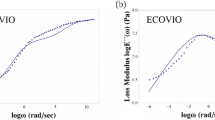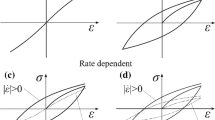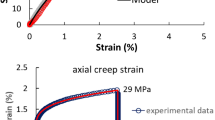Abstract
Appropriate knowledge of viscoelastic properties of polymers and elastomers is of fundamental importance for a correct modelization and analysis of structures where such materials are present, especially when dealing with dynamic and vibration problems. In this paper experimental results of a series of compression and tension tests on specimens of styrene-butadiene rubber and polypropylene plastic are presented; tests consist of creep and relaxation tests, as well as cyclic loading at different frequencies. Experimental data are then used to calibrate some linear viscoelastic models; besides the classical approach based on a combination in series or parallel of standard mechanical elements as springs and dashpots, particular emphasis is given to the application of models whose constitutive equations are based on differential equations of fractional order (Fractional Derivative Model). The two approaches are compared analyzing their capability to reproduce all the experimental data for given materials; also, the main computational issues related with these models are addressed, and the advantage of using a limited number of parameters is demonstrated.
Similar content being viewed by others
References
Adolfsson, K., Enelund, M., Olsson, P.: On the fractional order model of viscoelasticity. Mech. Time-Depend. Mater. 9, 15–34 (2005)
Alfrey, T.: Nonhomogeneous stress in viscoelastic media. Q. J. Appl. Math. 21(113), 113–119 (1944)
Amin, A.F.M.S., Alam, M.S., Okui, Y.: An improved hyperelasticity relation in modeling viscoelasticity response of natural and high damping rubbers in compression: experiments, parameter identification and numerical verification. Mech. Mater. 34, 75–95 (2002)
Atanackovic, T.M.: A modified Zener model of a viscoelastic body. Contin. Mech. Thermodyn. 14, 137–148 (2002)
Atanackovic, T.M., Stankovic, B.: Dynamics of viscoelastic rod of fractional derivative type. J. Appl. Math. Mech. 82, 377–386 (2002)
Bagley, R.L., Torvik, P.J.: Fractional calculus—a different approach to the analysis of viscoelastically damped structures. AIAA J. 21(5), 741–748 (1983)
Bagley, R.L., Torvik, P.J.: On the fractional calculus model of viscoelastic behavior. J. Rheol. 30, 133–155 (1986)
Beda, T., Chevalier, Y.: New methods for identifying rheological parameter for fractional derivative modeling of viscoelastic behavior. Mech. Time-Depend. Mater. 8, 105–118 (2004)
Bhuiyan, A.R., Okui, Y., Mitamura, H., Imai, T.: A rheology model of high damping rubber bearings for seismic analysis: identification of nonlinear viscosity. Int. J. Solids Struct. 46, 1778–1792 (2009)
Brinson, H.F., Brinson, L.C.: Polymer Engineering Science and Viscoelasticity—An introduction. Springer, Berlin (2008)
Coussot, C., Kalyanam, S., Yapp, R., Insana, M.F.: Fractional derivative models for ultrasonic characterization of polymer and breast tissue viscoelasticity. IEEE Trans. Ultrason. Ferroelectr. Freq. Control 56(4) (2009)
Craiem, D., Magin, R.L.: Fractional order models of viscoelasticity as an alternative in the analysis of red blood cell (RBC) membrane mechanics. Phys. Biol. 7, 013001 (2010)
Davis, G.B., Kohandel, M., Sivaloganathan, S., Tenti, G.: The constitutive properties of the brain paraenchyma Part 2. Fractional derivative approach. Med. Eng. Phys. 28, 455–459 (2006)
de Espındola, J.J., da Silva Neto, J.M., Lopes, E.M.O.: A generalized fractional derivative approach to viscoelastic material properties measurement. Appl. Math. Comput. 164, 493–506 (2005)
Fung, Y.C.: Foundations of Solid Mechanics. Prentice Hall, New York (1965)
Grahovac, N.M., Zigic, M.M.: Modelling of the hamstring muscle group by use of fractional derivatives. Comput. Math. Appl. 59, 1695–1700 (2010)
Hernandez-Jimenez, A., Hernandez-Santiago, J., Macias-Garcıa, A., Sanchez-Gonzalez, J.: Relaxation modulus in PMMA and PTFE fitting by fractional Maxwell model. Polym. Test. 21, 325–331 (2002)
Huber, N., Tsakmakis, C.: Finite deformation viscoelasticity laws. Mech. Mater. 32, 1–18 (2000)
Hwang, J.S., Wang, J.C.: Seismic response prediction of HDR bearings using fractional derivatives Maxwell model. Eng. Struct. 20, 849–856 (1998)
Koeller, R.C.: Applications of fractional calculus to the theory of viscoelasticity. J. Appl. Mech. 51, 299–307 (1984)
Lee, E.H.: Stress analysis in viscoelastic bodies. Q. Appl. 13, 183–190 (1955)
Lewandowski, R., Chorazyczewski, B.: Identification of the parameters of the Kelvin–Voigt and the Maxwell fractional models, used to modeling of viscoelastic dampers. Comput. Struct. 88, 1–17 (2010)
Li, C., Lua, J.: A hyper-viscoelastic constitutive model for polyurea. Mater. Lett. 63, 877–880 (2009)
Liu, J.G., Xu, M.Y.: Higher-order fractional constitutive equations of viscoelastic materials involving three different parameters and their relaxation and creep functions. Mech. Time-Depend. Mater. 10, 263–279 (2006)
Meral, F.C., Royston, T.J., Magin, R.: Fractional calculus in viscoelasticity: an experimental study. Commun. Nonlinear Sci. Numer. Simul. 15, 939–945 (2010)
Oldham, K.B., Spanier, J.: The Fractional Calculus. Academic Press, New York (1974)
Park, S.W.: Analytical modelling of viscoelastic dampers for structural and vibration control. Int. J. Solids Struct. 38(44–45), 8065–8092 (2001)
Popov, V.L., Geike, T.: A new constitutive model of rubber. Tribol. Int. 40, 1012–1016 (2007)
Pritz, T.: Five-parameter fractional derivative model for polymeric damping materials. J. Sound Vib. 265, 935–952 (2003)
Read, W.T.: Stress analysis for compressible viscoelastic materials. J. Appl. Phys. 21, 67–674 (1950)
Tschoegl, N.W.: The Phenomenological Theory of Linear Viscoelastic Behavior. Springer, Berlin (1989)
Welch, S.W.J., Rorrer, R.A.L., Duren, R.G.: Application of time-based fractional calculus methods to viscoelastic creep and stress relaxation of materials. Mech. Time-Depend. Mater. 3, 279–303 (1999)
Author information
Authors and Affiliations
Corresponding author
Rights and permissions
About this article
Cite this article
Sasso, M., Palmieri, G. & Amodio, D. Application of fractional derivative models in linear viscoelastic problems. Mech Time-Depend Mater 15, 367–387 (2011). https://doi.org/10.1007/s11043-011-9153-x
Received:
Accepted:
Published:
Issue Date:
DOI: https://doi.org/10.1007/s11043-011-9153-x




